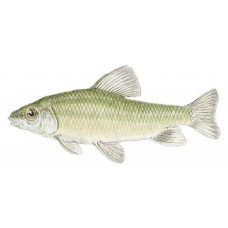Latin name
Erimyzon oblongus
Other names
No information
Identification
Chubsuckers are characterised by their small, protruding, sucker-like mouths and thick, fleshy lips. Creek, lake and chubsucker sharpfins are similarly greenish-bronze in colour and have no lateral line. There are usually 10 to 12 dorsal rays and 7 anal rays. The scales have dark margins, and in creek chubsuckers there are dark spots. The juvenile chubsucker has a concentrated black stripe from the tip of the snout to the tail, with a yellow stripe on top. The breeding male is dark with a pink-orange tinge and several tubercles on each side of the snout. The brook chubsucker has a plump body, while the lake and sharpfin chubsuckers are slightly more elongated. All suckers except the chubsucker have a fully developed lateral line.
Distribution
Creek chubsuckers inhabit the waters of the Great Lakes and Mississippi River drainages south to the waters of Georgia and the Gulf Slope. Lake and sharpfin chubsuckers inhabit waters similar to those favoured by creek chubsuckers, including waters as far west as Oregon and as far south as Florida.
Habitat
Warm, clear water in streams, small rivers, lakes, ponds and marshes, or any water without turbidity, is a favourable environment. Chubsuckers are rarely found in streams, preferring the depths of calm, still waters. As bottom dwellers, they prefer sand, gravel or shingle bottoms with abundant vegetation.
Size
Chubsuckers can grow to 13-15 inches, but rarely exceed 10 inches in length. The average age of a chubsucker is 5 years, although one can live up to 8 years.
Life history and Behavior
Spawning takes place in small tributaries in early spring. Sometimes the male will build a nest, but the eggs are usually scattered randomly on the sand, gravel or vegetation below and left to hatch unattended.
Food and feeding habits
Spawning takes place in small tributaries in early spring. Sometimes the male will build a nest, but the eggs are usually scattered randomly on the sand, gravel or vegetation below and left to hatch unattended.
Reproduction
No information
| Classification | |
| Phylum | Chordata |
| Class | Actinopterygii |
| Squad | Cypriniformes |
| Family | Catostomidae |
| Genus | Erimyzon |
| Species | E. sucetta |
| Features | |
| Conservation status | No information |
| Habitat | Bottom |
| Life span, years | 8 |
| Maximum body weight, kg | No information |
| Maximum length, cm | 38.1 |
| Sailing speed, m/s | No information |
| Threat to people | Edible |
| Way of eating | Predator |


